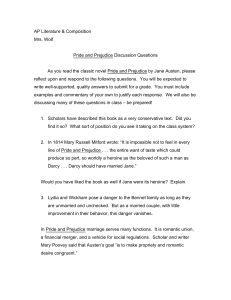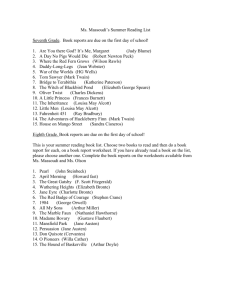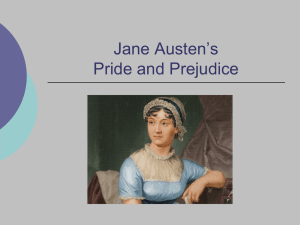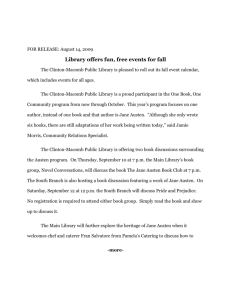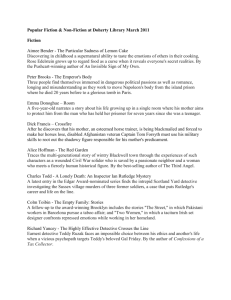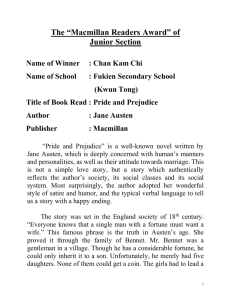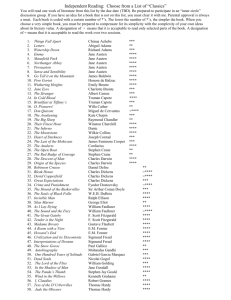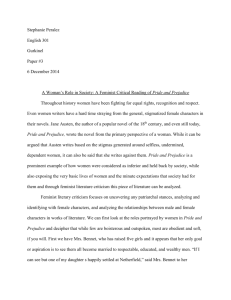play guide - Actors Theatre of Louisville
advertisement
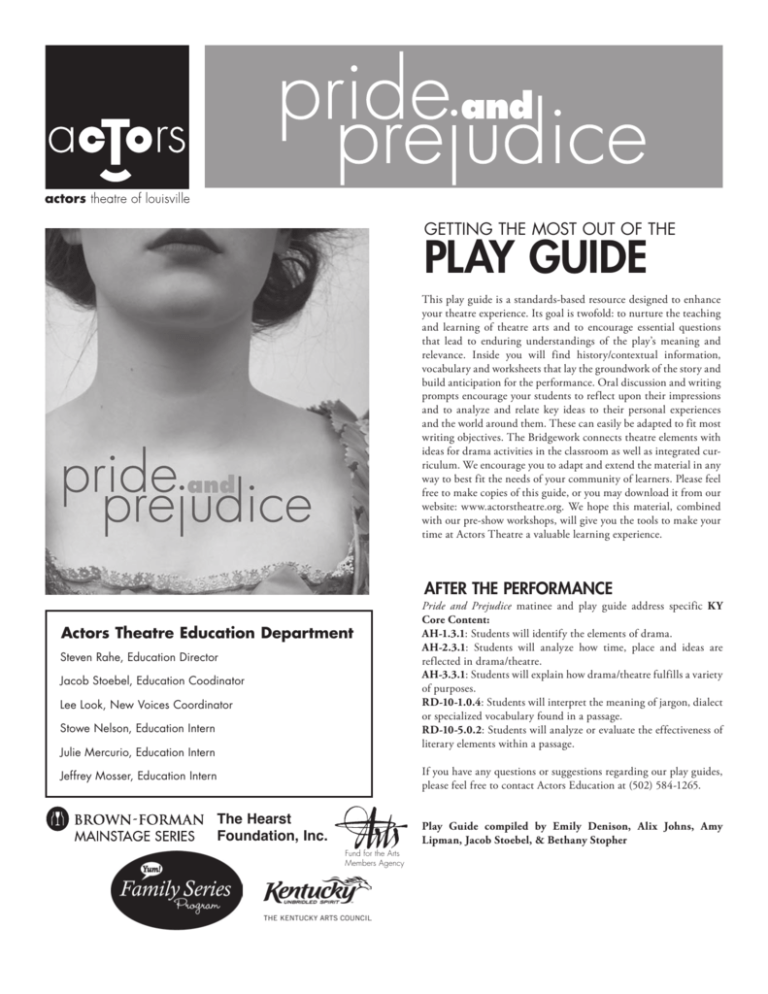
Getting the Most Out of The PLAY Guide This play guide is a standards-based resource designed to enhance your theatre experience. Its goal is twofold: to nurture the teaching and learning of theatre arts and to encourage essential questions that lead to enduring understandings of the play’s meaning and relevance. Inside you will find history/contextual information, vocabulary and worksheets that lay the groundwork of the story and build anticipation for the performance. Oral discussion and writing prompts encourage your students to reflect upon their impressions and to analyze and relate key ideas to their personal experiences and the world around them. These can easily be adapted to fit most writing objectives. The Bridgework connects theatre elements with ideas for drama activities in the classroom as well as integrated curriculum. We encourage you to adapt and extend the material in any way to best fit the needs of your community of learners. Please feel free to make copies of this guide, or you may download it from our website: www.actorstheatre.org. We hope this material, combined with our pre-show workshops, will give you the tools to make your time at Actors Theatre a valuable learning experience. After the Performance Actors Theatre Education Department Steven Rahe, Education Director Jacob Stoebel, Education Coodinator Lee Look, New Voices Coordinator Stowe Nelson, Education Intern Julie Mercurio, Education Intern Pride and Prejudice matinee and play guide address specific KY Core Content: AH-1.3.1: Students will identify the elements of drama. AH-2.3.1: Students will analyze how time, place and ideas are reflected in drama/theatre. AH-3.3.1: Students will explain how drama/theatre fulfills a variety of purposes. RD-10-1.0.4: Students will interpret the meaning of jargon, dialect or specialized vocabulary found in a passage. RD-10-5.0.2: Students will analyze or evaluate the effectiveness of literary elements within a passage. If you have any questions or suggestions regarding our play guides, please feel free to contact Actors Education at (502) 584-1265. Jeffrey Mosser, Education Intern The Hearst Foundation, Inc. Play Guide compiled by Emily Denison, Alix Johns, Amy Lipman, Jacob Stoebel, & Bethany Stopher Fund for the Arts Members Agency WHAT IT’S ALL ABOUT Pride & Prejudice Synopsis The village of Longbourn, home to the Bennet family, is excited by the news that a wealthy young man named Bingley has rented the nearby manor at Netherfield. After all, the five unmarried Bennet sisters know “it is a truth universally acknowledged that a single man in possession of a good fortune must be in want of a wife.” Mr. Bingley brings his good friend Mr. Darcy with him, who is as rude as Bingley is kind. Darcy gets off on the wrong foot with Elizabeth, the clever but plain-looking Bennet daughter. They engage in several verbal spars, and as Elizabeth tries in vain to speak for women, Darcy cannot help but fall in love with her quick wit—and her. Meanwhile, Mr. Bingley and Jane are growing closer, despite the Bennet family’s modest social status, a deterrent that nearly pries them apart forever. The pompous Mr. Collins is in town to make arrangements to inherit the Bennet home (as only men could), and plans on marrying any one of the sisters while he is visiting Longbourn. Mr. Wickham, a dashing young soldier, is in town, too, and he’s got his eyes on more than one of the Bennet sisters... Who does he charm, and what transpired between he and Mr. Darcy years ago? Mrs. Bennet is constantly troubled by as she attempts to see all five of her daughters married and secure, a feat that often seems impossible. The joys are romantic, but the troubles bring heartache as these young women struggle for a place behind their husbands, or perhaps, beside. List of Themes: Love Social Class Reputation Wealth Marriage Family Virtue 2 List of Characters: AMATEUR THEATRICS... Elizabeth Bennet: Lizzie, as she is sometimes called, is the protagonist of the play and second eldest daughter. She has a passionate, if sometimes jumbled, relationship with Mr. Darcy. Mr. Darcy: The rich friend of Mr. Bingley, he quarrels and eventually falls in love with Elizabeth. Mr. Bennet: Patriarch of the Longbourn estate, Mr. Bennet is a placid husband to Mrs. Bennet and protective father to five girls. Mrs. Bennet: The Bennet girls’ mother, who is set on their making auspicious marriage arrangements. Jane Bennet: The eldest of the sisters, she marries Mr. Bingley. Mr. Bingley: The gentleman who rents Netherfield Park and falls in love with Jane. Miss Bingley: Mr. Bingley’s snobby sister. Lady Catherine de Bourgh: Mr. Darcy’s aunt who is sure no one is good enough for their family. She is also the patroness of Mr. Collins, meaning she pays for his parsonage of their church. Mr. Collins: A distant cousin of the Bennets; a foolish parson who proposes to Elizabeth. He eventually marries Charlotte Lucas. Mary Bennet: The middle Bennet sister, not as flighty as Kitty & Lydia, but not as refined as Jane & Elizabeth. Lydia Bennet: A flirt who elopes with Mr. Wickham – a very scandalous action! Mr. Wickham: The soldier who romances Elizabeth and then Lydia. He also had a romantic relationship with Georgiana, Darcy’s younger sister, and knew Darcy when they were younger. Kitty Bennet: Lydia’s companion, who also enjoys ribbons and flirting. Charlotte Lucas: Lizzie’s good friend and confidante, who marries for security, not love. Mr. Lucas: Charlotte Lucas’ father. Mr. & Mrs. Gardiner: Elizabeth’s aunt and uncle who bring Jane to London and accompany Lizzie to Pemberley. Georgiana: Mr. Darcy’s younger sister, once wooed by Wickham. The Austen family was very witty and spent many hours playing verbal games, creating clever verse and riddles, and even producing “amateur theatricals.” The family would often read aloud at night, but not always, so as to include the youngest children too. They often gathered with friends to play a game where each person had to try writing an impromptu poem in which every line rhymed. The group would chose a word—“rose” for example—and each poet would base their rhyme scheme on the chosen word. Jane Austen’s mother was arguably the wittiest in these competitions, though Jane was a close second. Until Jane was about fourteen, the family would also create short “plays,” generally performed in the parlor or in some cases, the barn. Love & Marriage novels are centered upon being a decent and moral person. She did not, however, believe that such a person must also be devastatingly beautiful. While Jane’s beauty far eclipses Elizabeth’s, Darcy eventually proclaims Elizabeth, not Jane, to be one of the “handsomest women” he knows. Additionally, Elizabeth is principally a woman of good character and sensitivity, and despite her voracious reading, does not harbor any snobbery towards others. She is a worthy companion and partner for Darcy, but is not defined by him. This makes Elizabeth Bennet, as expressed by Jane Austen, “as delightful a creature as ever appeared in print.” During Regency era in which Elizabeth lived, the question was not whether to marry, but to whom. Elizabeth’s independence in the face of this society is estimable. Her refusal to Darcy and Collins, and later, her strength in the face of Lady Catherine’s threat shows a character that is above all, worthy of happiness. And for Jane Austen’s heroines, a fitting husband was of the utmost significance, and who was more deserving of such a reward than Elizabeth Bennet? Did You Know? “Anything is to be preferred or endured rather than marrying without Affection.” Jane Austen, letter to her niece Fanny, 1814 Jane Austen was never married, and we can only speculate through her correspondence with her sister Cassandra as to whether she was ever truly in love. Even the work of J.E. Austen-Leigh, Jane’s nephew and biographer, does not provide concrete answers with regard to Austen’s own experience of love. The characters, relationships and stories she crafted in her novels provide the clearest window into Jane Austen’s personal opinions of love, friendship and marriage. In Pride and Prejudice, Charlotte Lucas, Elizabeth Bennet’s friend and confidante, accepts the insufferable Mr. Collins’ loveless marriage proposal, though Lizzie was unable to resign herself to such a bleak future. In this situation, our heroine’s love life mirrors that of her authoress. Austen’s best friend, Harris Bigg-Wither, proposed to her in 1802, when she was 27 years old -- the same age as Charlotte. Jane accepted his proposal, knowing that he was the heir to a fine estate and that she would inherit a decent life. But a future without love prompted Jane to withdraw her acceptance the very next morning. Though she was committing herself to spinsterhood, dependent on the generosity of her brothers, she remained convinced that “nothing can be compared to the misery of being bound without Love, bound to one, and preferring another.” Jane Austen’s views on love helped to give purpose to her writing. Her desire was to be a good influence on her readers and society, and her The word “feminist” didn’t come into our lexicon until eighty years after Jane Austen! Jane Austen read Fanny Burney’s book Camilla, in which, Burney used the phrase “pride and prejudice” several times. Young Miss Austen changed her novel’s name from First Impressions to Pride and Prejudice following that discovery. 3 FROM PAGE TO STAGE Bringing a novel to life on stage is difficult, and not just because fitting 400 pages of story into 90 pages of script means cutting out events, storylines and even whole characters. It’s also difficult because there are things Austen can tell a reader of her book that the audience watching a play can’t know. For instance, Jane Austen can write “her thoughts naturally flew to her sister,” but there is no way for Jon Jory to tell his audience what a character is thinking. To make things even harder, when you’re working with a story as well-loved as Pride and Prejudice, you have to make sure that die-hard fans will love your play. Jon Jory sat down to write his adaptation with all of these things in mind. He has said that adaptors have two options: “You can follow the main story and do so fully, or you can sample all of the stories that are told in the book, putting in four lines of this and four lines of that. That tends to wear out the audience. I stuck with the central story, making it as complete as possible, and then filled in around the edges.” For Pride and Prejudice, this meant focusing on the love story between Elizabeth and Darcy. Events like Lydia’s elopement (which fills 40 pages in the novel!) are downplayed significantly (10 pages in the play). Additionally, more than 90 percent of the language Jory uses in the play comes directly from Austen’s novel, and he has the characters narrate events directly to the audience. Die-hard Austen fans can rest assured that the witty narration that makes her novels so wonderful is recreated on the stage, and Jory can explain details to his audience that he might otherwise have to leave out. Below is an example of exactly how this works. Compare the original passage by Jane Austen with Jon Jory’s version for the play. From Jane Austen: It is a truth universally acknowledged, that a single man in possession of a good fortune must be in want of a wife. However little known the feelings or views of such a man may be on his first entering a neighborhood, this truth is so well fixed in the minds of the surrounding families, that he is considered as the rightful property of some one or other of their daughters. “My dear Mr. Bennet,’’ said his lady to him one day, “have you heard that Netherfield Park is let at last?’” Mr. Bennet replied that he had not. “But it is,’’ returned she; “for Mrs. Long has just been here, and she told me all about it.” Mr. Bennet made no answer. “Do not you want to know who has taken it?” cried his wife impatiently. “You want to tell me, and I have no objection to hearing it.’” This was invitation enough. “Why, my dear, you must know, Mrs. Long says that Netherfield is taken by a young man of large fortune from the north of England; that he came down on Monday in a chaise and four to see the place, and was so much delighted with it that he agreed with Mr. Morris immediately; that he is to take possession before Michaelmas, and some of his servants are to be in the house by the end of next week.” “What is his name?” “Bingley.” “Is he married or single?” “Oh! single, my dear, to be sure! A single man of large fortune; four or five thousand a year. What a fine thing for our girls!” “How so? how can it affect them?” “My dear Mr. Bennet,” replied his wife, “how can you be so tiresome! You must know that I am thinking of his marrying one of them.” “Is that his design in settling here?” “Design! Nonsense, how can you talk so! But it is very likely that he may fall in love with one of them…” 4 From Jon Jory: MRS. BENNET. My dear Mr. Bennet, have your heard that Netherfield Park is let at last? MR. BENNET. I have not. MRS. BENNET. But it is, for Mrs. Long has just been there and she told me all about it. LYDIA. Probably an elderly bachelor with a King Charles spaniel. MRS. BENNET. Indeed, Mr. Bennet, do you not want to know who has taken it? MR. BENNET. You want to tell me, and I have no objection to hearing it. MRS. BENNET. Mrs. Long says that Netherfield is taken by a young man of large fortune… LYDIA. Married or single? MR. BENNET. We might first enquire of the gentleman’s name, Lydia. MRS. BENNET. Bingley. KITTY. But, married or single? MRS. BENNET. Oh, single, my dears, to be sure! A single man of large fortune; four or five thousand a year. MARY, KITTY, LYDIA: (To the audience) It is a truth universally acknowledged that a single man in possession of a good fortune must be in want of a wife. ELIZABETH. However little known the feelings or views of such a man may be, this truth is so well fixed in the minds of the surrounding families… (Now speaking to Jane) That he is considered the rightful property of some one or others of their daughters. JANE. Oh dear. MRS. BENNET. Hush, Lizzy. What a fine thing for our girls. MR. BENNET. How so? KITTY. That he might marry one of us, Papa. MR. BENNET. And that is his design in settling here? MRS. BENNET. Design? Nonsense. But it is not unusual that a young man may fall in love. Pride and Prejudice Through the Years In the nearly 200 years since it was first published, Austen’s novel has been adapted to different formats countless times. In addition to more than 30 sequels, here are a few of the different versions: 2008: Lost in Austen (A modern Austen fan magically switches places with Elizabeth Bennett) 2007: Pride and Prejudice (Play by Jon Jory) 2005: Pride & Prejudice (Film starring Keira Knightley) 2004: Bride and Prejudice (Modern film version set in India) 2003: Pride and Prejudice: A Latter-Day Comedy (Modern film adaptation set in Mormon community in Utah) 1995: “Furst Impressions” (Episode of children’s television show, Wishbone) 1995: Pride and Prejudice (BBC Television series starring Jennifer Ehle and Colin Firth) 1967: Pride and Prejudice (The first filmed version to appear in color) 1959: First Impressions (Broadway musical) 1940: Pride and Prejudice (A film version starring Greer Garson and Laurence Olivier) 1938: Pride and Prejudice (The first television adaptation) 1936: Pride and Prejudice (A Broadway play by Helen Jerome) A playbill from a 1959 production of First Impressions. Playbill cover for Helen Jerome’s 1935 adaptation. The wedding of Elizabeth and Darcy in a BBC version of Pride and Prejudice. Greer Garson and Laurence Olivier starred in this 1940 adaptation of Pride and Prejudice. Jon Jory’s Adaptation “This play, the way it disarms you so that you can go a little deeper inside it is to charm you.” –Jon Jory Jon Jory was Producing Director at Actors Theatre of Louisville for thirty-one years, and in 1976 he started the Festival of New American Plays. Now in its 32nd prestigious year, and having been funded by the Humana Foundation since 1979, the Humana Festival serves American dramatic literature immeasurably. Jory is also the author of Tips: Ideas for Actors (2000), Tips: Ideas for Directors (2002) and Tips II for Actors (2005). Devoted to encouraging new writers and their plays while maintaining a high standard for production excellence, Jory’s adaptation of Pride and Prejudice premiered in Tucson on September 10, 2005. The world premiere was a co-production between Arizona Theatre Company (where it played in both Tucson and Phoenix), San Jose Repertory Theatre and Alliance Theatre in Atlanta. 5 Roles of Women “No [woman] can be really esteemed accomplished, who does not… have a thorough knowledge of music, singing, drawing, dancing, and the modern languages […] she must possess certain something in her air and manner of walking, the tone of her voice, her address and expressions.” —Miss Bingley, Pride and Prejudice A great deal was expected of women during the Regency Period (the late 18th and early 19th century, when King George IV was a regent—replacement leader—for his father George III, who had become too ill to lead the country himself). In addition to the talents Miss Bingley lists, women were also expected to adhere to strict rules of behavior. Often referred to as the “Cult of True Womanhood” or the “Cult of Domesticity,” these rules were created and enforced by novels, textbooks and magazines many women read. According to the Cult of Domesticity, a true woman should always show piety, purity, submissiveness and domesticity. The first and most important womanly quality was piety. This means not only a fervent belief in the Christian God and his power, but also a devotion to living life in a Christian manner. For a woman, this meant marrying, having children, and raising those children to have firm, Christian beliefs. Next, it was required that women remain pure. This meant not having any kind of improper contact with a man (which includes things like kissing or even holding hands!), and reading only what was considered appropriate for women (such as books of letters about how to behave or novels with good, Christian morals). It was also considered a very important part of a woman’s purity not to seek any kind of recognition outside of the home. Writing novels, for instance, was scandalous, and women like Jane Austen had to use pen names or risk ruining their reputations. To avoid impropriety, first Austen’s father and later her brother communicated with publishers for her. Furthermore, on her first novel, Sense and Sensibility, the author was listed as “A Lady,” and Pride and Prejudice was attributed to “The Author of Sense and Sensibility.” Acting was another occupation that was considered impure for cultured young women. The Regency woman was also expected to be submissive at all times. For single women, this meant obeying their fathers in everything. Though marriages were no longer arranged and the new, fashionable manners allowed a young man to propose to a young woman before asking her father’s permission, it was still illegal for a young woman under twenty-one to marry without her father’s consent. This is because women did not have the legal right to sign a contract or own property; their fathers had to do these things for them. When a woman married, her husband took over these duties, and she was expected to be submissive to her husband just as she had been to her father. Finally, women had to be domestic. For lower-class women, this meant learning to cook, sew, clean, and perform any other household chores. For wealthier women like those in Pride and Prejudice, it meant knowing how to hire, supervise, and control servants and household spending. A high-society woman might also learn to sew, but only for decorative purposes, or if her family was having financial trouble and needed to make their own clothes. And to all these traits, as Miss Bingley points out, a gentlewoman was expected to add artistic accomplishment. She took classes in drawing and music, and studied languages to be able to use French phrases in everyday conversation. The life of the Regency woman was, without a doubt, a difficult one. Top Ten Ways to be Vulgar in Regency England: 10) Broadcast your knowledge and opinions as widely as you can. 9) Remember: what happens in Scotland, stays in Scotland. This neighboring country was the place of choice for hasty marriages and elopements. 8) Be cutting edge with your fashions. Put some plums on your bonnet, even if no one else is doing it! 7) Carry on a conversation with someone to whom you have not been introduced. 6) Have a prominent or affluent relative, and be sure to spread the word so everyone knows of your influence in society. 5) Gossip! And use slang when you do. 4) Hey fellas! Do you fancy a special lady? Take her for a ride in your carriage…without an escort! 3) Laugh. Loudly! And as often as you can. It doesn’t really matter what you’re laughing at. 2) Touch a member of the opposite sex anywhere but their hand in public. 1) As a woman, write and publish a novel, and take credit for your work! 6 SPEECH What’s the Big Deal? Jane Austen’s work has seen countless adaptations on the BBC, for feature film, in Bollywood, and on the stage. Why? If you haven’t read the books, you may be wondering that very thing. Is it really those two magical words: Mr. Darcy? Likely, it’s not. Though actors portraying Elizabeth Bennet’s surly, passionate match often have no equal in physical splendor, Jane Austen’s immense talent probably has more to do with her work’s popularity. Besides, as Austen said, “A lady’s imagination is very rapid; it jumps from admiration to love, from love to matrimony in a moment.” Of course, when confronted with such specimens of male beauty –with just the right amount of curmudgeonly class, it is not a surprise that audible gasps emerge not just from the armchair anymore, but the audience. Where Austen’s magic truly lies is in her speech. Divided opinions of her work may exist, but none can contest her interesting characters, clever dialogue, and a plethora of ironic situations. Jane Austen was an accomplished writer, from the beginnings in Juvenilia (a collection of short stories, poems, and plays she wrote as a child) to the posthumously published Persuasion and Northanger Abbey. It is no surprise that, despite the multitude of adaptations, no silent film adaptation exists—her words are too important. In adapting the novel for the stage, Jon Jory faced the exceedingly difficult task of cutting a 350 page book into a 90 page play. He remarks, “I tried to include as close to every damn word of it as I could.” And there was plenty of fodder; Jane Austen’s books are dripping in dialogue – good dialogue, too, where characters have voices and motivations. The result? Leaving dialogue where he could, transforming some of the authoress’ narration into dialogue, and letting some narration stay narration. A unique way to present a play, surely, but because even the narration is so stylistically similar to Austen, the important part of Austen’s work is realized. Her words, when given to us on the stage, remind the audience of being read a book, but this time, there are pictures. At the end of the novel, Elizabeth asks Darcy “to account for his having ever fallen in love” with her: “I can comprehend your going on charmingly once you had made a beginning, but what could set you off in the first place?” “I cannot fix the hour, or the spot, or the look, or the words, which laid the foundation. It is too long ago. I was in the middle before I knew I had begun.” “My beauty you had early withstood, and as for my manners – my behavior to you was at least always bordering on the uncivil, and I never spoke to you without rather wishing to give you pain than not. Now be sincere; did you admire me for my impertinence?” “For the liveliness of your mind, I did.” This table at Chawton Cottage is where we presume Jane Austen wrote. 7 Best and Worst Dressed A woman dressed appropriately for taking a walk, as Jane Austen often did. What a sophisticated lady may have worn to a ball. This overcoat is trimmed with lace. The woman on the left is ready for a ball, and on the right is a woman ready for her afternoon walk. This gentleman was the height of fashion. These London women were drawn in 1814. 8 Dances This room was where the city of Bath held their social gatherings and dances. A poster for the Angel Inn from 1862. An assembly room was above the stables and could hold up to 30 couples for monthly dances. These chorus girls from First Impressions exemplified vulgarity. Dancing was a rare and welcome opportunity for couples to be together. The Austen family’s music book, which Jane transcribed. Not quite an English Country Dance… Survivors of the Terror (or French Revolution) whose relatives had been executed used to give what they called ‘Bals des victimes,’ or Victims’ Balls, around the turn of the nineteenth century. The certificate of admission? Prove that a member of your family had been guillotined. Ladies were sure to accessorize with a thin red ribbon tied around the neck at the point of the guillotine blade’s impact. Men, instead of bowing to their partner before dancing, would salute by jerking their heads down sharply, in order to mimic the moment of decapitation. 9 CRIBS A HOUSE CALLED KNOLE This house was Jane Austen’s insipiration for Pemberley, Mr. Darcy’s home. Giving us the V.I.P. tour of Mr. Darcy’s fab country estate, Pemberley, is his housekeeper, Mrs. Reynolds. Darcy would never show off his crib himself because those kind of shenanigans would be trashy. Plus, Mrs. Reynolds always gives tours to fams passing by on vacay. D. Dog’s drawing room is just as swank as this one from Penrhyn Castle. First, we head into the drawing room. A must-have for any rich dude, the drawing room is where Mr. Darcy chills with his peeps and displays the family bling or heirlooms. Only the very wealthy can have a drawing room since they are mainly for show. Our man, Darcy, has several. 10 D. has a gallery just like this one in Pembroke Castle. Upstairs, the long gallery is where it’s at. Another favorite in the cribs of the rich and famous, this long, narrow room exists just to show off the owner’s slammin’ art collection. This means pics of family members as well as other celebs the family hangs with. CRIBS D. Slice has way more books than this fool, but otherwise his library looks a lot like this one for the Duke of Wellington. And, of course, owning a Regency crib without a library would be whack. These books have been collected by generations of Darcys and show us what sick taste and education they have. (And these pages are totes expensive, so hands off!) Mr. D. has way sicker grounds than those shown here, but they are totes natural, like these. Don’t forget to check out the grounds before you peace out! Digs like Pemberley come with private parks for the use of the fam and their homies. Old school parks were carefully designed mazes of paths with posh sculpted plants, but Mr. Darcy prefers the new “in” style of more natural gardens. Our dawg has his own stream to fish in and probably a separate park for getting his hunt on, pwning fish and deer. Thanks for chillin’ with us here at Pemberley! Join us next time when we check out Darcy’s main man, Mr. Bingley, and his sweet digs at Netherfield Park. 11 Time Period All of Jane Austen’s novels were published during the Regency Era, that is to say, when the Prince Regent was England’s monarch. Jane Austen was born in 1775, near the beginning of the American Revolution. King George III, though alive longer than Austen, was replaced by his son, George IV, in 1811 due to the King’s insanity. Thought today to be only a metabolic disorder, the King’s symptoms were so severe that upon fear of political upheaval the 1811 Regency Act was passed to put the younger George in the throne as England’s Prince Regent. War colored most of Jane Austen’s life. The American Revolution raged during her childhood years, the French Revolution was sparked when she was a teenager, leading into the French and Napoleonic Wars. With mass communication not instantaneous as it is today, families were not too connected to world affairs. Because half of Jane’s brothers were in the military, though, the Austen family had more accurate reports of military news. In Meryton, we see the youngest Bennet girls cavort with the militia. Lydia, in fact, pursues a relationship with Mr. Wickham. England’s militia was only active when the army was stationed abroad. The purpose of the militia was for home defense and the men were all volunteers. Usually poor or imprisoned men were given the opportunity to be soldiers instead of, as the Duke of Wellington said, “the scum of the earth.” Officers, however, were of a more genteel upbringing. To have a career in the military required money or connections with influential men. Jane Austen was forced to dedicate Emma to this gross man. Jane Austen’s novel Emma was dedicated to the Prince Regent. He considered himself a great patron of arts and architecture, and kept copies of Austen’s books in all his residencies. Due to his self-indulgent, spendthrift, and immoral ways, Austen did not return the regard he gave to her. In fact, upon hearing of the Prince Regent’s separated wife’s grievances, Austen wrote, “Poor Woman, I shall support her as long as I can, because she is a Woman, and because I hate her Husband.” Unfortunately for Jane, two years later the Prince, gross in manner and appearance, proved that he appreciated the beauty of literature by insisting that she dedicate Emma to him. Considering his offenses to women, Jane Austen must have been sorely displeased to oblige. Syllabub “Her face was as white as a Whipt syllabub…” – Lesley Castle from Jane Austen’s Volume the Second of the Juvenilia Jane Austen mentions dance halls with adjoining rooms full of tables groaning under the weight of suppers, gives quick comment to the breakfasts families ate together, and talks of some meals, perhaps of asparagus and lobster, that her characters indulge in. Of course, Austen spent much more of her words describing relationships than roasts. But she was particularly fond of a popular beverage that mixed milk and alcohol: syllabub. Generally, a syllabub has whipped cream, whipped egg white (or meringue), lemon juice, lemon zest, sugar, nutmeg, and wine to give it flavor. One recipe, found in a book written in 1871, instructs the cook to mix the other ingredients together in a bowl, and then “place the bowl under the cow, and milk it full.” Here’s a version of syllabub you can make at home: 1 cup heavy whipping cream, chilled ½ cup white sugar ¼ cup cold white grape juice 2 tablespoons fresh lemon juice 1 teaspoon lemon zest A sprinkle of nutmeg, and mint leaves and lemon slices for garnish Whip the cream and sugar together in a cold bowl till the cream thickens. Add the grape juice slowly, then the lemon juice and lemon zest. Whip until it’s light and fluffy, but not grainy. Cover and chill till serving time. Serve in goblets, and sprinkle with nutmeg, and garnish with mint and lemon. Eat with a small spoon 12 Who Said It? A Quiz to Test Your Familiarity With Jane’s Words… 1) “One cannot be always laughing at a man without now and then stumbling on something witty.” A. Ellen DeGeneres B. Eve Ensler C. Jane Austen 2) “The person, be it gentleman or lady, who has not pleasure in a good novel, must be intolerably stupid.” A. Stephen King B. Jane Austen C. J.R.R. Tolkien 3) “Why not seize the pleasure at once? How often is happiness destroyed by preparation, foolish preparation!” A. Martha Stewart B. Jane Austen C. Julia Child 4) “From politics, it was an easy step to silence.” A. Jane Austen B. Colin Powell C. Bill Clinton 5) “My sore throats are always worse than anyone’s.” A. Britney Spears B. Alex Trebek C. Jane Austen 6) “An artist cannot do anything slovenly.” A. Jane Austen B. Jim Henson C. Michelangelo Answer: Jane Austen said all of them! 13 How to Get a Girl in 1813 Step 1: Gain entrance to fashionable clubs by following proper behavior codes and establish your place in society. Close attention to fashion and athletic hobbies are a must! Step 2: Attend as many balls, dinner parties, and other social gatherings as possible. Step 3: Request an introduction to the girl of your choice. A relative or an acquaintance must introduce you. Step 4: Be seen dancing with, or socially accompanying, the young lady you have chosen and request to call on her at home. Step 5: Call on the girl at home where your visit will be chaperoned and last no more than 20 minutes. Also, accompany her to social events or on drives. Step 6: Tell the girl how you feel and ask for her hand in marriage. Step 7: Ask the girl’s father for his blessing and permission to marry his daughter. Step 8: Publish your engagement in the papers. Step 9: Get a marriage license and be sure to post announcements called banns in the paper for three weeks before your wedding. Step 10: Get married! Dollars and Cents Today, when someone makes £20,000 a year (£ is the symbol for an English pound, similar to the U.S. dollar), it probably means that person has a job to earn that money. In Pride and Prejudice, when the characters indicate that Bingley has £4,000£5,000 a year, it does not mean the same thing. Gentlemen of Austen’s time inherited land, which they charged others to farm on, and they also invested money. In this way, they made money each year without ever having a job. Since the amount of money your family had determined where you could go, who you could be friends with, and even who you married, it was very important to be wealthy. Mr. Darcy Mr. Bingley Mr. Bennett Shopkeepers Governess Here are some sample annual incomes and their equivalent in today’s dollars. England, 1813 America, 2008 £10,000 $11,644,053.03 £4,500 $5,239,479.31 £2,000 $2,328,859.69 £150 $174,601.79 £15 $17,460.19 An 1816 payment of £38 to Jane Austen. 14 BRIDGEWORK: A Teacher’s Tool to Building Connections between Stage and Classroom Core Content Connection - The following activities are designed using the Elements of Drama: Literary Elements, Technical Elements and Performance Elements. (Core Content 4.1) AT YOUR DESK Activities ON CONTEMPORARY JANE AUSTEN: STATUS CARD GAME: Materials: One deck of cards Distribute a card to each student, and instruct them not to look at their own card. Holding their card on their foreheads so others can see it, allow them to walk around the room and react to their classmates’ cards. The higher the card, the higher the status they have, and the more respect they should be given. (Aces and face cards would be the highest, whereas a two would have the least amount of status.) After a few minutes, ask your students to arrange themselves into a line according to what they think their status is, based on how they have been treated for the past few minutes. Pride & Prejudice takes place two hundred years ago. Individually or with a small group, choose a small scene from the adaptation to contemporize. Your scene should be guided by the dialogue and stage directions, but fit well into the 21st century. What sort of things do you need to change about the physical part of theater? What would your characters be wearing? If the original scene took place at a ball, where could today’s scene happen? Have attitudes changed as to how men and women can behave, as individuals and especially, with each other? How does the contemporary scene reflect that? In the original scene, find what each character wants from the other. What is the point of the scene? Is it possible to adapt the scene’s modernity without compromising the themes? Would your adaptation be popular today? Why do you think that Jane Austen’s works are still so popular? What are her stories about? COLLAGE: Make a collage of pictures from magazines or your own artwork that reflects what the play’s themes, or ideas, are. Share with your classmates. What did you think the story was about that perhaps a peer did not see? What is in everyone’s collage? DRAW A POSTER: Draw a poster for our production of Pride & Prejudice. What’s special about it? What will catch people’s eye? YOUR FEET Activities DISCUSS: How does it feel to be treated poorly by your peers? How did it feel to be treated extremely well, even though you were no different? How could you tell what your status was, and what were some clues you gave to your classmates to help them figure out who they were? Was it difficult to find your place if you held a middle card? DISCUSS THE PLAY: Think about which characters have the most and least status in Pride & Prejudice. How are they treated in the play by other characters? Does status matter in that time period? Does it matter today? WANT TO KNOW MORE? CHECK OUT THESE SOURCES! On Jane… Jane Austen: Obstinate Heart by Valerie Grosvenor Myer Jane Austen, A Companion by Josephine Ross Jane Austen’s World: The Life and Times of England’s Most Popular Author by Maggie Lane The Cambridge Companion to Jane Austen by Edward Copeland and Juliet McMaster Jane Austen in Hollywood by Linda Troost and Sayre Greenfield The Friendly Jane Austen by Natalie Tyler On the life and times… What Jane Austen Ate and Charles Dickens Knew: From Fox Hunting to Whist—the Facts of Daily Life in 19th-Century England by Daniel Pool Regency Country House: From the Archives of Country Life by John Martin Robinson Georgian and Regency Architecture by Derek Avery Regency Style by Steven Parissien Letters on the Improvement of the Mind Addressed to a Young Lady by Hester Chapone The World of Jane Austen by Nigel Nicholson Mrs. Hurst Dancing, and Other Scenes from Regency Life, 1812-1823 by Diana Sperling The Writer’s Guide to Everyday Life in Regency and Victorian England: from 1811-1901 by Kristine Hughes The Regency Companion by Sharon H. Laudermilk & Teresa L. Hamlin On the web… The Republic of Pemberley, http://www.pemberley.com/ Encyclopedia Britannica Online, http://www.britannica.com/ 15 Writing Portfolio Note for teachers: All Writing Portfolio prompts have been designed to correspond with Kentucky Department of Education Core Content for Writing Assessment. 1. PERSONAL WRITING Consider the relationship that Mr. and Mrs. Bennet have with their children. They want what is best for their daughters, even though sometimes the girls disagree. Mrs. Bennet, for example, gives Mr. Collins permission to propose to Elizabeth. Think of someone you are close to who takes care of you and wants what is best for your future. Has there been a time when they’ve asked you to do something you didn’t want to do? Did you do it? Why do you think they asked you? Do you think they had your best interests at heart? Describe exactly what they asked of you, how you felt about it, what you decided to do, and how everything turned out. 2. TRANSACTIVE WRITING Pretend that Regency England is a place people can actually visit. Prepare a brochure for potential tourists, enlightening them about what they may expect on their vacation. What kind of home would they be staying in, and what form of travel would they use to get there? What sorts of clothes should ladies and gentlemen pack? How should they behave when in “Regency England”? What kinds of activities can they expect to participate in on their vacation? Make your brochure as honest as you can. Do you think people would want to visit there, and does your brochure reflect that? 3. LITERARY WRITING Letter writing was how people in Regency England generally communicated with one another. The post could circulate five to six times a day, in some cases, and those with servants often sent them out to deliver letters too. Imagine that you live in this era, and write your own letter to a friend that you’ve not seen for some time. Explain what you’ve been doing and ask about them/their family/their house. Be sure to cordially invite them to a ball you’re holding at the end of the month too. Sign your name at the bottom with a common Regency closing, such as “Affectionately yours,” “Yours ever,” or “Yours sincerely.” actors theatre of louisville n 316 West Main Street n Louisville, KY 40202-4218 Box office 502-584-1205 n Group Sales 502-585-1210 n Business Office 502-584-1265 ActorsTheatre.org 16
